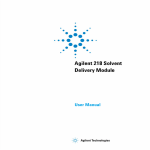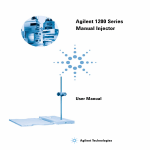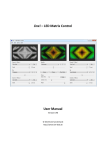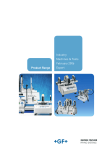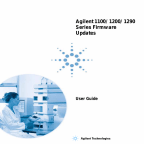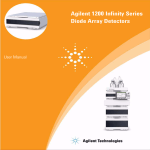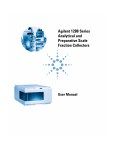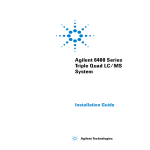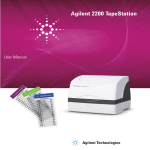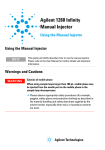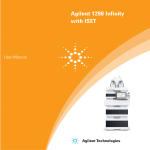Download 1200 Infinity Series Universal Interface Box
Transcript
Agilent 1200 Infinity Series Universal Interface Box Agilent Technologies Introduction The Agilent 1200 Infinity Series Universal Interface Box (G1390B) is a multipurpose accessory for the Agilent 1200 Infinity Series that extends instrument communication capability to high quality analog and digital output and input. It provides a general connection interface for existing and upcoming Agilent sensors (e.g. pH-, temperature-, leak- sensors) and other accessory equipment. Peak-based fraction collection with external detectors and mass-based fraction collection with Agilent MS rely on the Universal Interface Box II. The Agilent 1200 Infinity Series Universal Interface Box (shortly referred to as UIB II) replaces the Agilent 1100 Series Universal Interface Box (G1390A) which is designed for peak-based fraction collection with external 3rd party detectors via analog signal input or mass-based fraction collection with an Agilent MS via digital signal trigger. NOTE The older G1390A is only needed for peak-triggering with legacy Agilent 1100 Series LC-MSD (G1946 C/D) or Fraction Collector Devices without RC.net drivers. HiVijhA:9 ;gdcih^YZ >chigjbZciAVWZal^i] HZg^VaCjbWZg G^\]ih^YZ GZVgh^YZ AZ[ih^YZ Figure 1 2 Overview of Universal Interface Box II (UIB II) Features Feature summary: • Analog input for data collection from any type of 3rd-party detector such as evaporative light scattering, laser-induced fluorescence, refractive index or radioactivity detectors • Analog-to-digital conversion of analog input for full data analysis through Agilent chromatography data system, or for peak-based fraction collection triggered by baseline threshold or peak slope (peak width > 0.2 seconds) • Analog output to feed pump pressure traces or detector signals from Agilent LC modules to third-party data systems • General purpose input/output interface (GPIO/ERI) for digital mass-based fraction triggering and general purpose use • Low voltage output of 5 V and/or 24 V • Four timetable programmable relay contacts for control of external devices through close/open commands • External leak sensor with separate input line for improved lab safety • CAN connection to 1200 Series LC or 1200 Infinity Series LC modules 3 Deployment The following sections describe some of the options for connecting a 1200 Infinity Series LC instrument with other modules or devices. Additional Analog Out for every Agilent module to provide instrument or chromatography signals to 3rd party receivers (gYEVgin HnhiZb J>7>> 86CXdccZXi^dc idhnhiZb aZ[ih^YZ G8#cZi89H =EA8 A6Cid 89H G^\]ih^YZ 6cVad\Dji7C8 Figure 2 Connection to provide additional analog out NOTE Use any of the following cable options depending on input device: #061, #062, #064. For explanations of the option numbers refer to Table 2 on page 14. 4 3rd party detector signal acquisition (gYEVginYZiZXidg 6cVad\>c XdccZXi^dc J>7>> G8#cZi89H =EA8 86CXdccZXi^dc idhnhiZb aZ[ih^YZ A6Cid 89H G^\]ih^YZ Figure 3 Connection to 3rd party device NOTE Use any of the following cable options depending on output device: #063, #064. For explanations of the option numbers refer to Table 2 on page 14. 5 3rd party (Peak Detection) triggered fraction collection (gYEVgin9ZiZXidg 6cVad\>c XdccZXi^dc J>7>> 86CXdccZXi^dc idhnhiZb aZ[ih^YZ G8#cZi89H =EA8 ;8 A6Cid 89H 86CXdccZXi^dc idhnhiZb G^\]ih^YZ Figure 4 Connection to 3rd party device for fraction triggering NOTE Use any of the following cable options depending on output device: #063, #064. For explanations of the option numbers refer to Table 2 on page 14. 6 Mass-Based fraction collection BH J>7>> <E>DY^\^iVa XdccZXi^dc 86CXdccZXi^dc idhnhiZb aZ[ih^YZ G8#cZi89H =EA8 ;8 A6CidDA 8]ZbHiVi^dc 86CXdccZXi^dc idhnhiZb G^\]ih^YZ Figure 5 Connection for mass-based fraction collection NOTE Use following cable option for 61xx MS systems: #066. For explanations of the option numbers refer to Table 2 on page 14. 7 External Contacts Board for time table programmable relay switching allows control of peripheral equipment Hl^iX]9Zk^XZh J>7>> 86CXdccZXi^dc idhnhiZb aZ[ih^YZ =EA8 G8#cZi89H A6Cid 89H G^\]ih^YZ Id(gYEVgin YZk^XZh Figure 6 Connection to use external boards/relay switching functionality NOTE Use following cable option: #065. For explanations of the option numbers refer to Table 2 on page 14. 8 Connectors of the UIB II Overview of Connectors :miZgcVaXdciVXih :miZcYZYgZbdiZ ^ciZg[VXZ:G> 6cVad\>c 6cVad\Dji Figure 7 Right side of the UIB II 86Cedgih 8dc[^\hl^iX] :miZgcVaaZV`hZchdg XdccZXidg ;jhZh EdlZghl^iX] EdlZgXdccZXidg Figure 8 Left side of the UIB II 9 Typical Connection of UIB II to an Agilent LC Stack 6cVad\Djid[9ZiZXidg H^\cVa6dg7 G^\]ih^YZ 6cVad\Djid[ 9ZiZXidgdkZgJ>7>> H^\cVa6dg7 86CXdccZXi^dcJ>7>>id6\^aZci>chigjbZciHiVX` aZ[ih^YZd[i]ZJ>7>> Figure 9 Connection UIB II to an Agilent LC stack (example) Config Switch Settings of the UIB II 9^ehl^iX]& 9^ehl^iX]' Figure 10 Table 1 Config Switch Figure 11 Config Switch Settings Dipswitch 1 Dipswitch 2 ON (1) ON (1) 10 Function ON (1) OFF (0) OFF (0) OFF (0) Dipswitch 1 and 2 Forced Cold Start ON (1) OFF (0) Default/Standard Operation Mode Resident Mode Not Supported Special Settings Boot-Resident Firmware update procedures may require this mode in case of firmware loading errors (main firmware part). If you use the following switch settings and power the instrument up again, the instrument firmware stays in the resident mode. It is not operable as a module. It only uses basic functions of the operating system for example, for communication. In this mode the main firmware can be loaded (using update utilities). Forced Cold Start A forced cold start can be used to bring the module into a defined mode with default parameter settings. CAUTION Loss of data Forced cold start erases all methods and data stored in the non-volatile memory. Exceptions are calibration settings, diagnosis and repair log books which will not be erased. ➔ Save your methods and data before executing a forced cold start. Connector Descriptions Analog Out / Analog In H]^ZaY 6cVad\Dji " 6cVad\Dji" DjiejiKdaiV\Z/%#&"&K Figure 12 Analog Out Figure 13 Analog In 11 ERI / GPIO - & . &* Figure 14 ERI / GPIO Pin Enh. Remote 1 IO 1 2 IO 2 3 IO 3 4 IO 4 5 IO 5 6 IO 6 7 IO 7 8 IO 8 9 1wire DATA 10 DGND 11 +5 V ERI out 12 PGND 13 PGND 14 +24 V ERI out 15 +24 V ERI out ERI Interface (Enhanced Remote Interface) Description: This interface contains 8 individual programmable input/output pins. In addition it provides 24 V power and 5 V power and a serial data line to detect and recognize further add-ons that could be connected to this interface. This way the interface can support various additional devices like sensors, triggers (in and out) and small controllers, etc. 12 Relay / Aux. * & &% &* Figure 15 PIN + && Relay / Aux. Function 1 2 R1 3 4 R2 6 5 9 R3 8 7 10 R4 11 12 13 14 15 AUX 1 A-GND AUX 2 A-GND D-GND 13 Cables for UIB II Cable Overview UIB II Table 2 UIB II Cable Overview Option number Cable part number #061 8120-8140 Description Usage For Analog Out to BNC BNC to BNC #062 01046-60105 For Analog Out BNC to general purpose #063 35900-60910 For Analog Input C-Grid to general purpose #064 G1390-60002 For Analog Input/Out BNC to C-Grid 14 Table 2 UIB II Cable Overview Option number Cable part number #065 G1103-61611 Description Usage For External Contacts External contacts to general purpose #066 G1968-60805 For Mass-based Fraction Collection ERI to MS RJ-45 #067 5188-8029 General Purpose (GPIO/ERI) ERI to general purpose 15 Analog Cables p/n 8120-1840 p/n G1390-60002 p/n 01046-60105 16 Contact/Lead Signal Name Shield Analog - Center Analog + Contact Lead Signal Name 2 Analog - 3 Analog + Shield Analog - Center Analog + Contact/Lead Signal Name Black Analog - Red Analog + Shield Analog - Center Analog + p/n G35900-60910 Contact/Lead Signal Name 2 Analog - 3 Analog + Black Analog - Red Analog + 17 External Contact Cable 5 10 15 1 6 11 One end of this cable provides a 15-pin plug to be connected to Agilent modules interface board. The other end is for general purpose. Agilent Module Interface Board to general purposes p/n G1103-61611 18 Color Pin Agilent module Signal Name White 1 EXT 1 Brown 2 EXT 1 Green 3 EXT 2 Yellow 4 EXT 2 Grey 5 EXT 3 Pink 6 EXT 3 Blue 7 EXT 4 Red 8 EXT 4 Black 9 Not connected Violet 10 Not connected Grey/pink 11 Not connected Red/blue 12 Not connected White/gr een 13 Not connected Brown/gr een 14 Not connected White/yel low 15 Not connected General Purpose Cable Table 3 GPIO General Purpose Cable (5188-8029) descriptions Wire Color PIN Enh. Remote Green 1 IO 1 Violet 2 IO 2 Blue 3 IO 3 Yellow 4 IO 4 Black 5 IO 5 Orange 6 IO 6 Red 7 IO 7 Brown 8 IO 8 Gray 9 1 wire DATA NC 10 DGND NC 11 +5 V ERI out NC 12 PGND NC 13 PGND NC 14 +24 V ERI out White 15 +24 V ERI out 19 Representation in the Driver Software The representation of the UIB II in the dashboard of the Rapid Control LC Driver provides information on the following items: • Connectors • Analog In • Analog Out • Relay contacts • Voltage out information (if used) Figure 16 Table 4 Item Dashboard tile of the G1390B driver Function of items in UIB II graphic Function Shows the source of the Analog Out signal (upper) or Test Signal (lower) Shows the current states of the four external contacts Shows which Voltage Out voltages are currently enabled. 20 Appendix Electrical Connections • The CAN bus is a serial bus with high speed data transfer. The two connectors for the CAN bus are used for internal module data transfer and synchronization. • The power input socket accepts a line voltage of 100 – 240 VAC ±10 % with a line frequency of 50 or 60 Hz. Maximum power consumption varies by module. There is no voltage selector on your module because the power supply has wide-ranging capability. There are no externally accessible fuses, because automatic electronic fuses are implemented in the power supply. NOTE Never use cables other than the ones supplied by Agilent Technologies to ensure proper functionality and compliance with safety or EMC regulations. Serial Number Information 1200 Series and 1290 Infinity The serial number information on the instrument labels provide the following information: Format CCIIISSSSS CC CC country of manufacturing • DE = Germany • JP = Japan • CN = China III identifier: normally only changed at significant modifications SSSSS real serial number 21 Physical Specifications Table 5 Physical Specifications Type Specification Weight 0.9 kg (2 lbs) Dimensions (height × width × depth) 165 x 135 x 55 mm (6.5 x 5.3 x 2.2 inches) Line voltage 100 – 240 VAC, ± 10 % Line frequency 50 or 60 Hz, ± 5 % Power consumption 140 VA / 65 W Ambient operating temperature 4–55 °C (39–131 °F) Ambient non-operating temperature -40 – 70 °C (-40 – 158 °F) Humidity < 95 % r.h. at 40 °C (104 °F) Operating altitude Up to 2000 m (6562 ft) Non-operating altitude Up to 4600 m (15091 ft) For storing the module Safety standards: IEC, CSA, UL Installation category II, Pollution degree 2 For indoor use only. 22 Comments Wide-ranging capability Maximum Non-condensing Technical and Performance Specifications Table 6 Performance specifications Type Comment High breaking capacity fuse 2.0 A, 250 V Signal specifications: CAN 2-wire serial bus system Analog-input Input Range= -1 V to 1 V Resolution = 24 bit A/D-Converter Effective System Resolution = +/- 1 uV (rms) GPIO TTL compatible Input and Output Open collector characteristic Input voltage range 0 V to 5 V Relay outputs 2 contact closure outputs and 2 double throw outputs Imax = 250 mA Umax = 30 V DC/AC The contacts are protected by a self-resetting PTC-fuse 23 Delivery Checklist Ensure all parts and materials have been delivered with your module. The delivery checklist is shown below. Please report any missing or damaged parts to your local Agilent Technologies sales and service office. p/n Description G1390-90010 1200 Infinity Series UIB-II User Manual EN G4800-64500 Agilent 1200 Infinity Series User Documentation DVD 5181-1519 CAN cable, Agilent module to module, 1 m Power cord Damaged Packaging If the delivery packaging shows signs of external damage, please call your Agilent Technologies sales and service office immediately. Inform your service representative that the instrument may have been damaged during shipment. CAUTION "Defective on arrival" problems If there are signs of damage, please do not attempt to install the module. Inspection by Agilent is required to evaluate if the instrument is in good condition or damaged. ➔ Notify your Agilent sales and service office about the damage. ➔ An Agilent service representative will inspect the instrument at your site and initiate appropriate actions. 24 Condensation CAUTION Condensation within the module Condensation will damage the system electronics. ➔ Do not store, ship or use your module under conditions where temperature fluctuations could cause condensation within the module. ➔ If your module was shipped in cold weather, leave it in its box and allow it to warm slowly to room temperature to avoid condensation. Bench Space The module dimensions and weight (see Table 5 on page 22) allow you to place the module on almost any desk or laboratory bench. It needs an additional 2.5 cm (1.0 inches) of space on either side and approximately 8 cm (3.1 inches) at the left side for air circulation and electric connections. If the bench shall carry a complete HPLC system, make sure that the bench is designed to bear the weight of all modules. Do not cover ventilation slots of the module. 25 Power Cords Different power cords are offered as options with the module. The female end of all power cords is identical. It plugs into the power-input socket at the left side. The male end of each power cord is different and designed to match the wall socket of a particular country or region. WA R N I N G Absence of ground connection or use of unspecified power cord The absence of ground connection or the use of unspecified power cord can lead to electric shock or short circuit. ➔ Never operate your instrumentation from a power outlet that has no ground connection. ➔ Never use a power cord other than the Agilent Technologies power cord designed for your region. WA R N I N G Use of unsupplied cables Using cables not supplied by Agilent Technologies can lead to damage of the electronic components or personal injury. ➔ Never use cables other than the ones supplied by Agilent Technologies to ensure proper functionality and compliance with safety or EMC regulations. WA R N I N G Unintended use of supplied power cords Using power cords for unintended purposes can lead to personal injury or damage of electronic equipment. ➔ Never use the power cords that Agilent Technologies supplies with this instrument for any other equipment. 26 Power Considerations The module power supply has wide ranging capability. It accepts any line voltage in the range described in Table 5 on page 22. Consequently there is no voltage selector at the left side of the module. There are also no externally accessible fuses, because automatic electronic fuses are implemented in the power supply. WA R N I N G Hazard of electrical shock or damage of your instrumentation can result, if the devices are connected to a line voltage higher than specified. ➔ Connect your instrument to the specified line voltage only. WA R N I N G The module is partially energized when switched off, as long as the power cord is plugged in. Repair work at the module can lead to personal injuries, e.g. electrical shock, when the cover is opened and the module is connected to power. ➔ Always unplug the power cable before opening the cover. ➔ Do not connect the power cable to the instrument while the covers are removed. CAUTION Inaccessible power plug. In case of emergency it must be possible to disconnect the instrument from the power line at any time. ➔ Make sure the power connector of the instrument can be easily reached and unplugged. ➔ Provide sufficient space behind the power socket of the instrument to unplug the cable. 27 The Waste Electrical and Electronic Equipment Directive Abstract The Waste Electrical and Electronic Equipment (WEEE) Directive (2002/96/EC), adopted by EU Commission on 13 February 2003, is introducing producer responsibility on all electric and electronic appliances starting with 13 August 2005. NOTE This product complies with the WEEE Directive (2002/96/EC) marking requirements. The affixed label indicates that you must not discard this electrical/electronic product in domestic household waste. Product Category: With reference to the equipment types in the WEEE Directive Annex I, this product is classed as a Monitoring and Control Instrumentation product. NOTE Do not dispose off in domestic household waste To return unwanted products, contact your local Agilent office, or see www.agilent.com for more information. 28 Safety Symbols Table 7 Safety Symbols Symbol Description The apparatus is marked with this symbol when the user should refer to the instruction manual in order to protect risk of harm to the operator and to protect the apparatus against damage. Indicates dangerous voltages. Indicates a protected ground terminal. Indicates eye damage may result from directly viewing the light produced by the deuterium lamp used in this product. The apparatus is marked with this symbol when hot surfaces are available and the user should not touch it when heated up. WA R N I N G A WARNING alerts you to situations that could cause physical injury or death. ➔ Do not proceed beyond a warning until you have fully understood and met the indicated conditions. CAUTION A CAUTION alerts you to situations that could cause loss of data, or damage of equipment. ➔ Do not proceed beyond a caution until you have fully understood and met the indicated conditions. 29 Operation Before applying power, comply with the installation section. Additionally the following must be observed. Do not remove instrument covers when operating. Before the instrument is switched on, all protective earth terminals, extension cords, auto-transformers, and devices connected to it must be connected to a protective earth via a ground socket. Any interruption of the protective earth grounding will cause a potential shock hazard that could result in serious personal injury. Whenever it is likely that the protection has been impaired, the instrument must be made inoperative and be secured against any intended operation. Make sure that only fuses with the required rated current and of the specified type (normal blow, time delay, and so on) are used for replacement. The use of repaired fuses and the short-circuiting of fuse holders must be avoided. Some adjustments described in the manual, are made with power supplied to the instrument, and protective covers removed. Energy available at many points may, if contacted, result in personal injury. Any adjustment, maintenance, and repair of the opened instrument under voltage should be avoided whenever possible. When inevitable, this has to be carried out by a skilled person who is aware of the hazard involved. Do not attempt internal service or adjustment unless another person, capable of rendering first aid and resuscitation, is present. Do not replace components with power cable connected. Do not operate the instrument in the presence of flammable gases or fumes. Operation of any electrical instrument in such an environment constitutes a definite safety hazard. Do not install substitute parts or make any unauthorized modification to the instrument. Capacitors inside the instrument may still be charged, even though the instrument has been disconnected from its source of supply. Dangerous voltages, capable of causing serious personal injury, are present in this instrument. Use extreme caution when handling, testing and adjusting. 30 When working with solvents, observe appropriate safety procedures (for example, goggles, safety gloves and protective clothing) as described in the material handling and safety data sheet by the solvent vendor, especially when toxic or hazardous solvents are used. Safety Standards This is a Safety Class I instrument (provided with terminal for protective earthing) and has been manufactured and tested according to international safety standards. General Safety Information The following general safety precautions must be observed during all phases of operation, service, and repair of this instrument. Failure to comply with these precautions or with specific warnings elsewhere in this manual violates safety standards of design, manufacture, and intended use of the instrument. Agilent Technologies assumes no liability for the customer’s failure to comply with these requirements. WA R N I N G Ensure the proper usage of the equipment. The protection provided by the equipment may be impaired. ➔ The operator of this instrument is advised to use the equipment in a manner as specified in this manual. Agilent Technologies on Internet For the latest information on products and services visit our worldwide web site on the Internet at: http://www.agilent.com 31 *G1390-90011* *G1390-90011* G1390-90011 Part Number: G1390-90011 Edition: 02/2013 Printed in Germany © Agilent Technologies, Inc 2012, 2013 Agilent Technologies, Inc Hewlett-Packard-Strasse 8 76337 Waldbronn, Germany
































